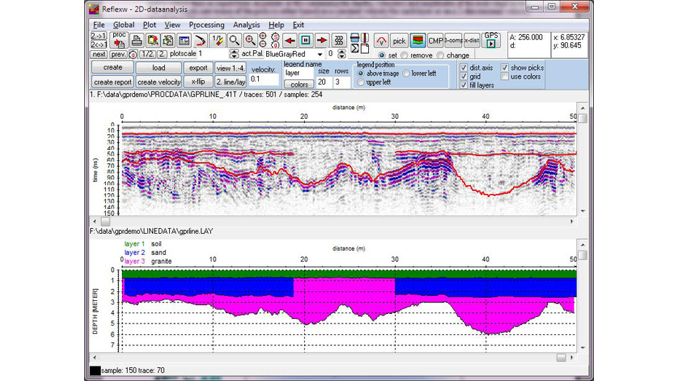

The forward modeling will be a combination of radar systems in two ways i.e. The forward modeling conducted will be processed in a computational model of the soil layer is converted into a synthetic form. The study focused on forward modeling of GPR reflection data. There are many analytical and numerical approaches taken by GPR researchers for forward modeling depending upon the application system. These include: forward time domain GPR modeling of bridge decks for detecting deterioration multi-region finite difference time domain (FDTD) simulation for airborne radar constructive inversion of vadose zone GPR observations, an approximate hybrid method for modeling of electromagnetic scattering from an underground target effectiveness of 2-D and 2.5-D FDTD GPR modeling for bridge-deck deterioration evaluated by 3-D FDTD, pseudo-full-waveform inversion of borehole GPR data using stochastic tomography. Moreover, some studies relating to forward modeling of GPR have been investigated.
#Reflex gpr demultiplex full#
A parallel 3-D staggered grid pseudo-spectral time domain method for ground penetrating radar wave simulation 2-D permittivity and conductivity imaging by full waveform inversion of multioffset GPR data: a frequency-domain quasi-Newton approach ground penetrating radar reflection attenuation tomography with an adaptive mesh. In the literature, several works have been reported in respect to the application of Ground Penetrating Radar (GPR) method for subsurface mapping. Whereas after measurement, the model’s simulation was made in order to facilitate the estimation of the reflection data process, in particular if model is estimated as soil layer with the raw data approach (drill data). In addition, the simulation could assist in estimating the physical parameters as well as the location of the material that is being measured or investigated. Before measurement, the model is simulated with a purpose of estimating the responses from the target.

The GPR modeling that is conducted in this study consists of soil layer models with forward modelings. To overcome this problem, the modeling is conducted in such a way that the material that is not dominating is ignored to facilitate the anomalies response analysis. An important issue in forward modeling is the noise resulting from the collision of waves or wave readable by the response after alternating wave in the medium, and read with a uniform response. Inhomogeneity in the medium is as a result of variations in properties like the conductivity (σ), electric permittivity (εr) and magnetic permeability (μ) from point to point due to different composition of the media. Misinterpretations in the estimation or identification of subsurface material during field measurement are generally due to the presence multiple noises from materials which are not dominant/inhomogeneous. Therefore, the velocity of the electromagnetic wave is primarily determined by the relative permittivity of the medium. In GPR target detection, the medium is generally considered as a non-magnetic medium. The contrast in the electrical properties of the materials leading to reflections of electromagnetic waves is used in obtaining vital information about the subsurface structure. Ground-penetrating radar (GPR) surveys are high resolution electromagnetic technique, non-destructive and environmental friendly for shallow subsurface mapping. Ground penetrating radar Forward modelling Radar responses Cavity Anomaly Introduction Comparison to a GPR synthetic data model shows a good accuracy of the forward modeling. For the two layers model, a diffraction response with wave travel time that longer in the side compared with the top of anomalous cavity is obtained using reflection profiling technique. Whereas, for the CMP the response profile gives oblique and hyperbolic patterns. The result of the three layers model shows that response profile obtained is similar to lithology models using reflection profiling technique. For synthesizing the models, the reflection profiling and common mid-point (CMP) were used for the radar data in providing framework in order to link subsurface properties and GPR data. Estimation of response profile in the soil layer from GPR synthetic data using forward modeling of radar data has been applied for reconstruction of 3 layers model without anomaly and 2 layers model with air-filled and water-filled cavity.


 0 kommentar(er)
0 kommentar(er)
